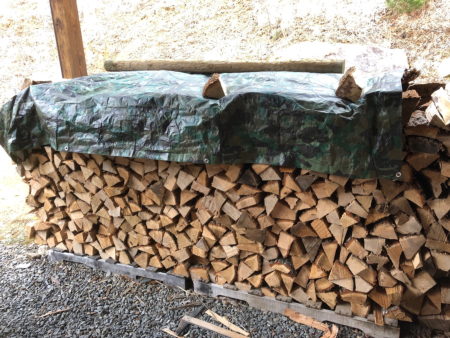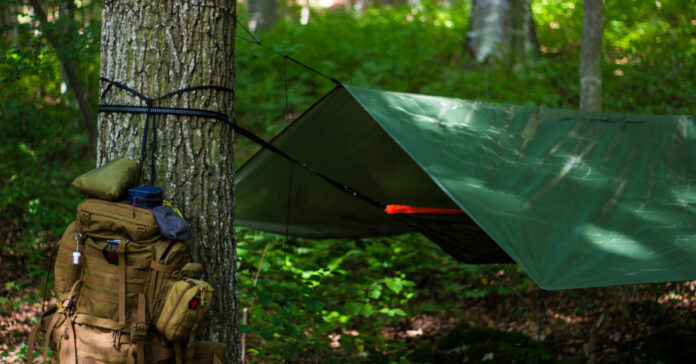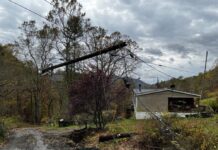If you don’t have at least a couple of tarps in your emergency stash, then you aren’t as covered (pun intended) in the shelter category as you thought.
Tarps are useful on the homestead, and I expect their utility will remain, if not increase, after the SHTF. I have a pile of tarps stored in my garage, and I buy a one or two new ones every year.
The smallest tarps I have are about 8’ x 5’, which is about the perfect size to wrap yourself in if you need an emergency overnight shelter. Use half of it as a ground cover and the other half to keep the rain and wind out. If you can find what locals call “a camping rock”, meaning a boulder with a nice overhang to crawl into, a tarp will work in conjunction with the rock to keep you snug and dry even in a heavy rain. Of course, if you don’t have a tarp, a GI poncho will also work.
If there are two people and you each have a tarp, use one as the ground cover and throw the other over a ridgeline to make an improvised tent-like shelter, similar to that seen in the main photo. If the rain is coming from one direction, you can anchor the tarp on that side and leave the opposite side open. You can also use tarps as a windbreak. Just keep them away from fires so they do not melt or burn.
A tarp can also help keep you dry inside a debris pile or a hasty lean to.
Vehicle Covers
I carry a 12’ x 12’ tarp in my truck so I can cover up anything I put in my truck bed if it looks like rain. On two occasions in the past year, I pulled over in a parking area and used bungees to strap the tarp over the back to keep the contents dry. In one instance, I beat the rain. In the other, I got wet, but kept the boxes back there from getting soggy.
When I know bad weather is a possibility, I lay the tarp down in the truck bed with the excess hanging out the tailgate. Then I load the bed, placing items on top of the tarp. Once the bed is full, I pull the tarp back over the items and strap it down. I am a big fan of bungees, but I also use ratchet straps.
Whether you are bugging out or just going on vacation, a tarp and some bungee cords can also protect whatever you put on your roof rack. Just wrap it well and keep the opening facing the rear so you are into forcing rain or debris into it as you drive. Besides keeping out the weather, it prevents prying eyes from seeing what you are hauling.
Keeping Equipment Dry
If you don’t have a barn, shed, or carport to protect your tractor, wood splitter, or other equipment, you can cover it in a tarp and wrap it up. Not only will this assure the seat is dry when you go to use it, the tarp helps protect the equipment from the effects of UV light and harsh weather. It’s not as secure as a shed, shop, or garage, but it’s better than nothing.

If you are storing an old car or an RV, you can buy tarps made to fit.
A month or two before I intend to burn my firewood, I cover it with a tarp. I just bought an 11’ x 6’ tarp which will be perfect for tarping my 10’ x 4’ row of firewood. I like the tarp to cover the top and hang down a foot or so, but it should never seal in the wood by covering it up completely. You want most of the woodpile exposed to the wind. What you don’t want is rain, snow, or ice to pill up on the wood so it is wet when you go to use it.
I also use a tarp to keep my hay bales dry.
Building a Bunker
If you build a foxhole, bunker, or improvised radiation shelter underground, a tarp can help keep the interior dry. After you dig your hole, build and reinforce your roof with logs or timbers and then add a layer of dirt over the logs. Slant the dirt so any water will run off instead of into the hole. Then put on the tarp and cover it with more dirt. This should keep the water from penetrating the roof. Tarps need to be well anchored or secured because if the wind picks up one corner, it will flap like a sail and before long the entire tarp will be loose, so pile plenty of dirt on top.
Repairs
If high winds or a falling tree damage your roof, you can make a temporary repair with a tarp. This is not my area of expertise, but I’ve seen a tarp laid over the damage section and then fixed in place with 1” x 3” boards that are screwed to the roof through the tarp. Doing this prevents the tarp from ripping free.
You often see tarped roofs after hurricanes pass through Florida. There are companies that specialize in tarping damaged roofs, so watch a how-to video or two for their advice on the best way to prevent leaks while waiting for roof repairs.
Bungees
When it comes to tying things down, the bungee strap is a modern marvel of great utility. It sure beats the cord the give you free at Lowes or Home Depot. Have a range of lengths to get the best fit.
The beauty of bungees is they give tarps some flex and stretch. This is important if it is windy or the tarp will be subjected to other stresses. The stretch can help keep the tarp from tearing or being punctured.
Of course, to work effectively, every tarp should have grommets through which you can stick the hook of a bungee or a piece of rope. Grommets can rip out, although they reinforce them on the best tarps. Get a grommet repair kit.
Grades of Tarp
Tarps come in a variety of thicknesses and dimensions. I recommend at least 10 mils. If you are comparing tarps in a store, it’s nice to see on the packaging that some are medium and others are heavyweight, but the mils let you compare tarps from multiple brands or between different stores. The longer a tarp will be in use and the more stress it is under, the heavier it should be.
In my experience, most tarps sold today are a woven polymer substrate with a solid material or coating impregnated into the woven fabric. These poly tarps are the most common and cheapest. Vinyl tarps are heavier and longer lasting but may be a specialty item.
The most common failures are caused by abrasion or by punctures. If you are stretching a tarp over something pointy, consider putting a sheet of corrugated cardboard or foam over the point to prevent wear. For example, if you load a dresser into the back of your truck, cover it with a tarp, and drive 200 miles, you will see wear marks or damage where the corner of the dresser pressed against the tarp.
Tarps come in a variety of colors. When you’re covering something up in the back of your truck or in your driveway, the color doesn’t matter. If you’re trying to cover something in the woods or use your carp to provide some camouflage, then you want to avoid a silver or blue tarp. Most of my tarps are brown on one side and green on the other.
Tarp Care
Today’s tarps are superior to old canvas tarps in many ways, including their lower weight. While they are not as prone to mildew, they may still mold if put away wet. If I need to put away a tarp that isn’t dry, I spread it out in my garage until the moisture evaporates. Only when it is dry do I fold it. You can also fold tarps into a long, narrow tube and then roll them up. This works well for a tarp you are carrying on a backpack.
I’ve tried to repair damaged tarps with duct tape, but that experiment failed. After the first cold, windy day, I had duct tape scattered in my yard and the holes had reappeared in my tarp. Maybe a higher grade of tape would have worked better. I’ve also tried to salvage the good end of a damaged tarp by cutting off the bad section, but that failed as well. Leave a comment if you have a successful tarp repair method.
When I have a damaged tarp now, I fold it in half, giving me a double layer. If the tarp is seriously damaged, I dispose of it and open a new one. Hey, that’s what the stack in the garage is for. Redundancy.








